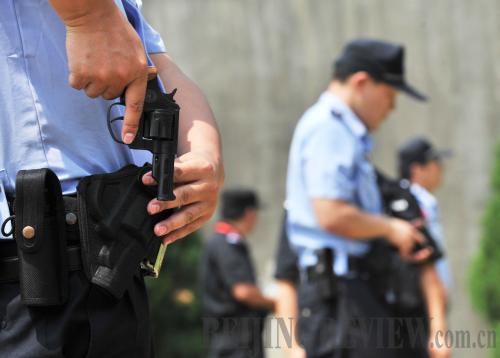|
 |
|
SAFETY FIRST: A police officer from Beijing's Haidian District holsters his weapon during live-fire training on June 26 (LI WEN) |
On July 15, the Beijing police force officially launched its second phase of firearms training, aiming to further improve its performance in response activities, especially the shooting skills of frontline policemen who are deployed during emergencies.
"Compared to the previous training at the end of June, the current one added live-fire drills under more complicated situations, requiring police officers to be able to shoot within 1 to 1.5 seconds while under high pressure," said Li Qiang, Deputy Director of the Fifth Section of the Criminal Investigation Corps of the Beijing Municipal Public Security Bureau.
Since April, some big cities in China, including Beijing and Shanghai, began dispatching armed police to patrol the streets, in the wake of a fatal knife attack on March 1 in Kunming, southwest China's Yunnan Province, which killed 29 people and injured 143 others.
In dealing with the attack, local police were alleged to have failed to tackle the knife-wielding perpetrators, due to lack of firearms.
Along with the rising number of patrolling police with firearms, a concern has also been aroused among the public about the reasonable use and the management of guns.
Rearmed officers
On April 20, some 1,000 police officers appeared on the streets of Shanghai, patrolling the city with firearms.
In addition to the guns, they carried seven other pieces of equipment with them—ammunition, tear gas, batons, handcuffs, flashlights, first-aid kits and walkie-talkies.
"Violent crimes have become real threats to public security and people's safety," said Rui Minghua, a senior police officer in Shanghai. "From now on, the Shanghai police will be able to stop any situation similar to the Kunming attack."
For many years, there has been a tight control on police usage of firearms in China due to its low violent crime rate. Before the recent policy change, Rui said that it had been 60 years since the last time Shanghai police were armed with guns when patrolling the streets.
However, an increase in violent crimes in recent years has prompted calls for arming the police.
In January 2011, two armed suspects shot dead four policemen and injured five others in Tai'an, east China's Shandong Province. In the case, unarmed policemen went to a suspect's home to investigate a murder; as soon as they identified themselves, the two men inside opened fire.
A similar incident occurred on March 29 this year, when a policeman was stabbed to death in Yidu in central China's Hubei Province. The officer, Hu Qinchun, reportedly fought back with his baton.
"The introduction of armed patrols is to improve the combat capabilities of frontline police officers and to effectively safeguard public security," said Yan Zhengbin, Deputy Director of the Public Security Management Bureau under the Ministry of Public Security (MPS).
Following Shanghai, police in several other cities, such as Beijing, Nanjing in Jiangsu Province and Urumqi in Xinjiang Uygur Autonomous Region, have also increased armed patrols on the streets.
More armed police will be deployed nationwide to conduct regular patrols in key areas as well as places with large numbers of people such as railway stations, airports, shopping malls, schools and hospitals, according to Yan.
"The presence of armed police on the streets will help prevent crime and improve security," said Dai Peng, Director of the Criminal Investigation Department of Beijing-based People's Public Security University of China. "The key issue is to regulate the use of the handguns to prevent the police from abusing their power."
The Regulations on Police Equipment and Weapons of China, which went into effect in 1996, stipulate 15 situations when an officer can open fire. These include arson, chance of explosion, murder, hostage taking, the hijacking of aircraft and other serious crimes that threaten public safety.
Police may shoot if a suspect fails to surrender after warnings. They may also shoot if there is no time for give a verbal warning or when issuing a warning could lead to fatal consequences.
The regulations, however, also list four situations when police should not fire: if a suspect is pregnant or a minor—unless they have committed a violent crime; if a suspect is in a crowded place or somewhere containing large quantities of flammables, explosives, poisonous or radioactive materials, unless not shooting would be more fatal; if the suspect has stopped their criminal activity; or if a suspect is incapable of committing further crimes.
Despite these rules, the current laws and regulations were written before today's security situation and some provisions are not detailed enough, according to legal experts.
| 